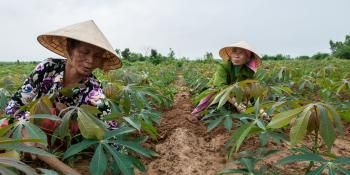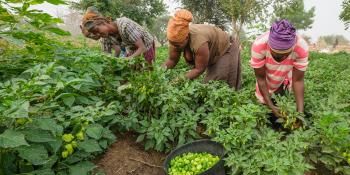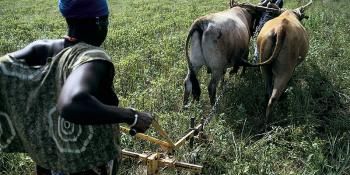Preserving genetic diversity: a climate change solution

Researchers work with farmers to fight climate change with biodiversity
Climate change is advancing faster than expected, and impacts are already being felt in agriculture. This means that all options for adaptation must be pursued to ensure future food security. This includes preserving crops, livestock, trees and aquatic organisms with the ability to endure and remain productive in a changing climate. The new book from the Food and Agriculture Organization of the United Nations (FAO), Coping with climate change: the roles of genetic resources for food and agriculture, sheds an important spotlight on linkages between genetic diversity and climate change in agriculture. The book includes a number of case studies, including ones prepared by CGIAR researchers, such as a study on plant genetic resources and food security by Andy Jarvis, who leads research on Climate-Smart Agriculture Practices for the CGIAR Research Program on Climate Change, Agriculture and Food Security (CCAFS).
Studying, preserving and utilizing genetic resources has become a key FAO strategy for coping with climate change in agriculture. The importance of this strategy is highlighted in a statement given by FAO’s Deputy Director-General Maria Helena Semedo, “In a warmer world with harsher, more variable weather, plants and animals raised for food will need to have the biological capacity to adapt more quickly than ever before".
CGIAR share FAO’s hopes to advance the understanding and preservation practices of genetic diversity by increasing on-site (in situ) gene banks in farmers’ fields. Not only will this help in the preservation of wild relatives and their ability to evolve, but will also assist in the protection of organisms that can only be sustained through human involvement, such as bananas and micro-organisms. Additionally, FAO strives to identify genetic adaptive traits within the existing (ex situ) conservation centers.
Researchers from CCAFS are currently engaged in a number of projects that further the study and protection of genetic diversity as a means of adapting to climate change. One such project, led by the International Center for Tropical Agriculture (CIAT), aims to strengthen the conservation and use of plant genetic resources, in Mexico and Central America. Another project, led by Bioversity International, works with Ethiopian farmers to develop on-site conservation for climate change adaptation. At the national level we see efforts geared towards the integration of genetic diversity in agriculture through National Adaptation Plans. These are only a few of many initiatives that work from the farm-level to the policy world.
Through the combined efforts of FAO, CGIAR and partners, we move another step closer towards a set of sustainable solutions for the rapidly advancing threat of climate change.
Melanie Mason is a research student assistant at the CCAFS Coordinating Unit. She is currently completing a Masters in Agricultural Development at the University of Copenhagen.
Check out our blog for more stories on genetic diversity and follow us on twitter at @cgiarclimate.



